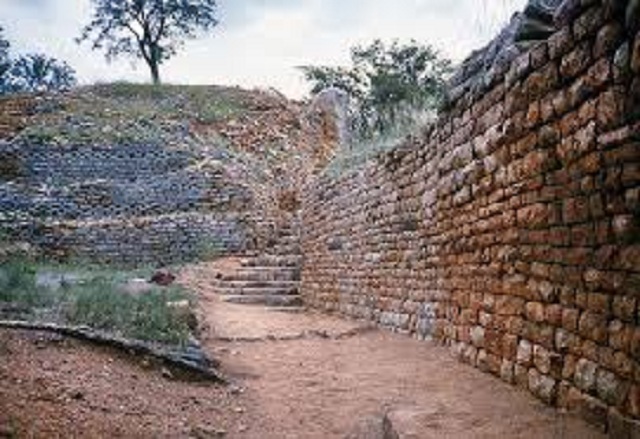
The Sunday News

Khami Ruins National Monument is located to the west of the Khami River, 22 km from Bulawayo. The property, located on a 1300 m hilltop downstream from a dam built during 1928-1929, covers an area of about 108 ha, spread over a distance of about 2 km from the Passage Ruin to the North Ruin.
The property was the capital of the Torwa dynasty, which arose from the collapse of the Great Zimbabwe Kingdom between 1450 -1650 and was abandoned during the Ndebele incursions of the 19th century. It is composed of a complex series of platforms of dry-stone walled structures, emulating a later development of Stone Age culture. The chief’s residence (Mambo), was located towards the north on the Hill Ruin site with its adjacent cultivation terraces. The population lived in daga huts of cob work, surrounded by a series of granite walls. These structures display a high standard of workmanship, a great number of narrow passageways and perambulatory galleries and impressive chevron and chequered wall decorations.
Khami conforms to Great Zimbabwe in a number of archaeological and architectural aspects but it possesses certain features particular to itself and its successors such as Danangombe and Zinjanja. Revetments or retaining walls found expression for the first time in the architectural history of the sub-region at Khami and with it were elaborate decorations; it still has the longest decorated wall in the entire sub-region.
The architecture of the site and the archaeological artefacts provide evidence for an exceptional understanding of strong, united, early civilisations. They also offer information on the property’s complex socio-economic, religious and spiritual significance for the local communities and for the overall chronological development of Zimbabwe tradition; initiated in Mapungubwe (South Africa), extending to Great Zimbabwe and through the emergence of later states. The archaeological remains are also a testament to long-distance historic trade links with the Portuguese and the wider world, the diverse range of imported artefacts provide evidence of 15th and 17th century Spanish porcelain, Rhineland stoneware and Ming porcelain, many of which are on display in the Museum of Natural History in Bulawayo. There is also a monumental granite cross, which illustrates the contact with missionaries at a traditionally revered and sacred spiritual site.
Khami is the second largest stone built monument in Zimbabwe. Its historical importance lies in its position at the watershed between the history of Great Zimbabwe and the later Zimbabwe period. It is one of the few Zimbabwe sites that were not destroyed by treasure hunters and its undisturbed stratigraphy is scientifically important in providing a much clearer insight into the history of the country. The climate supports a natural vegetation of open woodland, dominated by Combretum <http://www.worldlingo.com/ma/enwiki/en/Combretum> and Terminalia <http://www.worldlingo.com/ma/enwiki/en/Terminalia> trees. Being close to the Kalahari Desert <http://www.worldlingo.com/ma/enwiki/en/Kalahari_Desert>, the area is also vulnerable to droughts, and rainfall tends to vary considerably. The property has suffered some degradation due to variations in temperature, ground water, tourism, encroaching vegetation and applied preservation techniques.
The authenticity of the historic evidence is unquestionable. The ruins generally follow the pattern and style of the Great Zimbabwe ruins but are considered to be a later development of that culture. It remains an undisturbed, non-functional, archaeological site whilst also still being used by contemporary communities for spiritual purposes. The dry-stone building traditions enhance the sacredness of the area, where human presence is traceable over 100,000 years. Acknowledging huts made of cobwork (daga) enhanced by decorative friezes, and surrounded by a series of granite walls, and with a great number of passage ways and uncovered perambulatory galleries, the current population maintains the historic traditions of the site.
Khami has retained its authenticity largely in part due to the minimal interventions that have been carried out. All restorations have used traditional methods and no new materials have been added. Restorations nowadays are by anastylosis, which ensures that no new materials are introduced to the fabric of the site and promotes use of traditional methods of construction.
Protection and management requirements
The archaeological zone was protected as a ‘Royal Reserve’ until the death of King Lobengula in 1893. In recognition of the historic, cultural and architectural significance of the site, it was scheduled as a National Monument in 1937. Currently,the National Museums and Monuments Act Cap. 25:11 legally protect the property and its resources. Khami Ruins National Monument is managed by National Museums and Monuments,as overall responsible Agency. At local level, Khami falls under the Western Region administrative unit and a project manager, who liaises with the Regional Director and Executive Director on administrative and policy issues and is responsible for conservation and development.
The government of Zimbabwe partly funds conservation work and also makes available funds for capital improvements through its Public Sector Investment Programme (PSIP). National Museums and Monuments provide some funds raised through entrance fees, filming fees, etc. for conservation. International cooperation has existed for financial support, including assistance for the development of a conservation and site management plan. — .(source: whc.unesco.org)w



